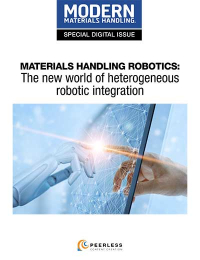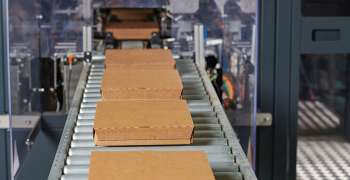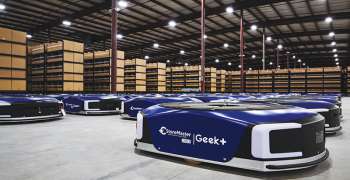Next-Level Productivity for Voice Directed Picking
Voice-directed picking and other types of voice solutions are proven in warehouse environments. But suppliers are now out to make voice-directed work even more productive with analytics and optimization, as well as improvements to the voice recognition engines.
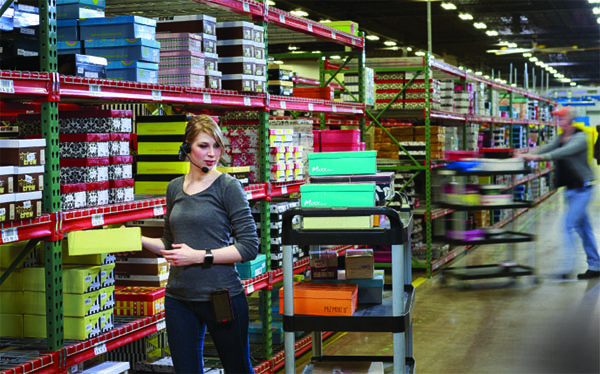
Suppliers of voice-directed systems are quick to point out how voice fits well with today’s e-commerce picking and fulfillment challenges because of the “hands-free” nature of voice directives versus using paper pick lists or wireless handhelds. By using Bluetooth headsets to hear verbal instructions and validate information back verbally to the system, voice keeps workers’ hands free for work tasks.
But voice productivity doesn’t stop there. In recent years, vendors have been bumping up the productivity of their solutions by doing things like applying analytics and optimization software to find further efficiencies, making improvements on speech recognition, and leveraging new device capabilities.
“You can pick up an additional 10% to 15% in productivity over the hands-free benefits of voice by using analytics to manage your operations,” says Keith Phillips, president and CEO of Voxware, whose suite spans voice automation and analytics. “Analytics lets you take actions like redeploying workers or reprioritizing orders to manage your activities on a real-time basis.”
Krishna Venkatasamy, chief technology officer for Lucas Systems, a provider of mobile work execution and voice applications, agrees that voice-directed workflows carry an inherent hands-free advantage and sees another couple of key ways voice solutions are building productivity.
One of these is with highly capable “multi-modal” devices that can support voice-directed work as well as the occasional bar code scan and then also capture radio frequency identification (RFID) tag data, or offer a screen to display or acquire information. The second path for next-level gains, Venkatasamy says, is through optimization software that does things like create highly efficient pick paths. “If you don’t give workers efficient work assignments, they can only be as efficient as the technology given to them to execute with, be that voice or multi-modal applications,” he says.
Optimization with Voice Technology
Lucas positions its optimization capability as “dynamic work optimization” within its Engage work execution software. The software does things like create optimal pick paths to reduce travel and intelligent batches that create optimal pick density. User organizations that have implemented Engage to create optimized batches are seeing productivity improvements averaging about 20%, and in some cases greater, Venkatasamy says.
“The goal is to make the entire flow through of a fulfillment center more efficient,” says Venkatasamy. “As part of addressing this goal, you need to ensure your pickers are touching product optimally and spending the least possible time walking. In other words, you want to maximize time spent picking and minimize time walking.”
According to Venkatasamy, while voice picking implementations may consider some basic location sequencing when devising batches, this amounts to rules logic that can’t optimize to the extent that an optimization engine employing multiple mathematical algorithms can.
 Engage’s algorithms are constantly assessing orders coming in from a warehouse management system or host system and weighing multiple factors to create optimal batches and pick paths, he explained.
Engage’s algorithms are constantly assessing orders coming in from a warehouse management system or host system and weighing multiple factors to create optimal batches and pick paths, he explained.
Engage considers factors including slot-level location of each item, directionality of the pick path, product dimensions, the ability to cut through aisles, user permissions and start/end points. The software rapidly crunches these factors while prioritizing tasks against the shipment timeframe that must be met. “Our focus with dynamic work optimization is on making sure that the work assignments being given to the pickers are more intelligent and more efficient,” Venkatasamy says.
Engage can also reprioritize assignments based on changing conditions, says Venkatasamy. “If a worker needs to skip an aisle because of congestion, we are automatically able to resequence the path,” he explains.
Voice recognition technology in the warehouse
Vendors are also working to make voice recognition more effective. While tech giants such as Apple (with Siri) and Amazon (with Alexa) are making voice a growing part of the consumer experience, voice-directed solution vendors for the warehouse say that these consumer-focused voice engines aren’t yet suitable for warehouse environments.
With the recent release of its Lydia Voice 8 voice system, Ehrhardt + Partner (E+P) has added neural network technology to improve voice recognition performance, according to Scott Deutsch, E+P’s North American president. It’s similar to the neural network technology used by Amazon for Alexa or by Apple with Siri, but tuned for the rigors of noisy warehouse environments, Deutsch says.
“With consumer voice technologies, most of you know that you sometimes end up having to repeat a question, but that’s just unacceptable in a warehouse environment where near-perfect voice recognition is required,” Deutsch says. “Warehouse workers simply can’t waste time repeating things.”

Analytics can spot patterns that help an organization fine tune the use of voice directed work.
However, adds Deutsch, E+P developers were able to use neural network technology—which uses high computing power to analyze large data sets to look for patterns—and adapt it to supply chain needs. E+P used “pruning” algorithms as part of neural network development to narrow down large data sets to find ways to improve voice recognition response time as well as to quickly understand tricky dialects, says Deutsch.
To improve Lydia’s understanding of mixed dialects, says Deutsch, E+P developers applied neural network technology against data from a customer site in Switzerland that had a tricky mixed dialect of German and Swiss inflections in workers’ voices. The new version offers about a 25% performance improvement in voice recognition over previous generations of the system, says Deutsch.
For workers, improved performance means quick interactions with the system with fewer instances of having to repeat information, says Deutsch. The improved engine also eliminates the need to use voice template training with new users, while also cutting the need to retrain the system should a worker’s voice change due to an issue like a sore throat.
Another recent enhancement to E+P’s Lydia is a function called Enterprise SiteSwitcher, which enables an IT department to set up and manage voice system security and profiles centrally. The devices used with the system are smart enough to adapt to each location’s security details, which allows for central device configuration with the ability to easily move devices from one location to another.
While the e-commerce picking pressures are making voice solutions attractive, vendors need to respond by making their systems easy to deploy, adds Deutsch. “Because of e-commerce’s peaks and valleys, and the struggles operations are having in finding people, voice solutions need to be extremely easy to roll out and get new users operational with rapidly,” he says.
Voice solutions for industry have in the past been mainly transactional—directing workers through routines like picking assignments or cycle counts, observes Dwight Klappich, a research vice president with analyst firm Gartner. However, Klappich believes the future lies in voice solutions that have “conversational” abilities—voice apps that can resolve exceptions by answering common sense questions, while also supporting transactional workflows. “Transactional voice is great and it works, but I believe the trend will be toward conversational voice—almost like a walkie talkie capability where the system is able to help resolve exceptions a worker comes across, like “I came to this bin, but it’s short on inventory.”
However, the major tech companies have not commercialized voice recognition for industrial applications, leaving it up to the industry-focused voice system suppliers to continue to enhance voice recognition on their own, say voice system vendors.
A few years ago, says Voxware’s Phillips, Voxware anticipated voice recognition from a major tech company might evolve in way that met the needs of industrial voice applications, so Voxware separated its application and voice recognition layers to take advantage of that scenario, but no third-party engine has emerged that can do the job. Voxware has tested some third-party voice technology, but found it didn’t suit industrial requirements, Phillips adds. “Our customers expect near 100% recognition—they can’t tolerate a worker losing 3 seconds by having to repeat something,” he says.
Analytics advantages
Analytics of the data and transactions generated by voice systems also serve as a way to squeeze more productivity from warehouse workflows. Phillips says Voxware’s analytics can do things like determine when it makes sense to move pickers from one area or zone of the warehouse to another based on current workloads. The vendor’s Cloud-based analytics can also tap into information from warehouse or transportation management systems to help make decisions about rebalancing labor in the warehouse or about delays in shipments that would impact execution.
Analytics can spot patterns that help an organization fine tune the use of voice-directed work, says Scott Powell, director of field and channel marketing and workflow solutions for Honeywell Safety and Productivity Solutions. The analytics package it offers—called Operational Acuity—looks at voice system data in the Cloud, to uncover patterns on how users are interacting with the system.
For example, analytics can tell if a worker might be adequate or good on his or her pick rate, but is using more “utterances” than normal back to the voice system. This sort of pattern might indicate a problem such as incorrect headset positioning, which if adjusted, might further help the productivity of the worker, says Powell.
Honeywell’s analytics solution has also been used to spot instances when the voice system’s commands have been sped up to a higher than recommended pace in an effort achieve greater throughput, which has resulted in more repeat “say again” utterances. “In this case, they slowed the system down slightly, and by slowing it down, the workers actually went faster,” says Powell.
Broad-based gains
While analytics are proving useful, says Powell, voice solution providers also need to continue to enhance voice recognition. One thing Honeywell has done with its Vocollect voice solution is come up with a capability called Sound Sense, that leverages multiple microphones built into the headset whereby one mic focuses on the worker’s voice and the other is oriented on filtering out background noise.
Another recent enhancement that helps productivity, says Powell, is a function called Touch Connect that accelerates user log on and shift start up. Simply by touching their voice device to a powered-up headset, this feature automatically logs the user in to start the shift. “Our approach with improvements is to really think about what the worker is doing, on what they are dealing with in their environment, and then make sure that everything just works,” Powell says. 
Voice also is being applied to other processes in a warehouse, including receiving and putaway, cycle counting, or packing and shipping stations, says Phillips. With Voxware’s support for smart glasses including glasses from Vuzix, Phillips adds, workflows such as packing can be enhanced having one device that supports voice interactions, scanning, and image and video capture. In a packing scenario, explains Phillips, voice directives using smart glasses could be combined with image capture with the glasses to take digital images that prove a package was packed correctly and was damage free.
Phillips advises that companies keep an open mind about how voice can enhance multiple processes within a warehouse, not just picking. “Voice picking is highly accurate, but some of the errors that occur are not because a worker is picking from the wrong location, but because the wrong item was put in the wrong location because replenishment was done incorrectly,” says Phillips. “So by using voice to get replenishment done more accurately, you’ll find that voice picking accuracy will probably go up, too. And when you layer analytics on top of it all, you can really drive maximum benefit.”
Companies mentioned in this article:

Article Topics
Magazine Archive News & Resources
Latest in Materials Handling
Registration open for Pack Expo International 2024 Walmart chooses Swisslog AS/RS and software for third milk processing facility NetLogistik partners with Vuzix subsidiary Moviynt to offer mobility solutions for warehouses Materials Handling Robotics: The new world of heterogeneous robotic integration BSLBATT is looking for new distributors and resellers worldwide Lucas Watson appointed CSO for Körber’s Parcel Logistics business in North America Hyster recognizes Dealers of Distinction for 2023 More Materials HandlingAbout the Author
Subscribe to Materials Handling Magazine

Find out what the world's most innovative companies are doing to improve productivity in their plants and distribution centers.
Start your FREE subscription today.
April 2024 Modern Materials Handling
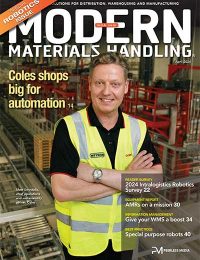
Latest Resources
